Exploring the Architectural Landscape of Sheikh Zayed Road
Intro
Sheikh Zayed Road, often regarded as the lifeblood of Dubai, runs like a golden thread through the city, connecting its past to its rapidly evolving future. This metropolitan artery is flanked by a stunning array of skyscrapers and buildings that stand as testaments to the ambition and creativity of architects and urban planners. The structures lining this thoroughfare are not merely functional edifices; they embody the aspirations of a city that has transformed itself within a few decades into a global hub for business and tourism.
In this article, we will embark on an exploration of the architectural marvels along Sheikh Zayed Road. From the distinctive silhouette of the Burj Khalifa to the sleek curves of the Emirates Towers, each building tells a story rooted in innovation and design excellence. Through our lens, we’ll consider how these structures influence community life, urban planning, and the economic landscape of Dubai. By the end of our journey, readers will gain a nuanced understanding of this iconic road and its significance in shaping Dubai's architectural identity.
Neighborhood Features
Landscaping Highlights
Sheikh Zayed Road isn't just about towering buildings and reflective glass; it's peppered with landscaped areas that break up the urban sprawl. One prominent example is the vast green spaces such as the Dubai Water Canal, where locals often gather for evening walks, cycling, or picnics along the water's edges.
Plants native to the region often dot the landscape, adding splashes of green amidst the concrete. These include species like date palms and acacia, which not only thrive in the desert climate but also provide shade and beauty. The incorporation of water features, such as fountains and reflective pools, enhances the aesthetic appeal, making a simple drive along the road a feast for the senses.
Architectural Styles
The architectural styles along Sheikh Zayed Road are as diverse as the cultures represented in Dubai.
- Modernist Designs: Buildings like the Burj Khalifa exemplify modern architecture with their sleek lines and minimalist touches, pushing the envelope of engineering while reaching for the sky.
- Postmodern Influences: The Emirates Towers reflect a postmodernist approach with their distinctive triangular shapes, showcasing artistic flair.
- Futuristic Facades: Many new additions to the skyline sport futuristic facades undoubtedly influenced by organic forms and sustainable design principles.
This blend of styles creates a fascinating urban tapestry that reflects not just the architectural trends of the times but also the intercultural dialogue present in Dubai.
Community Life
Local Events and Activities
The area surrounding Sheikh Zayed Road is vibrant with activities that engage residents and visitors alike. Events range from cultural festivals celebrating various heritages to art fairs showcasing local talents. The Dubai Shopping Festival often sees the road bustling with shoppers and explorers, further solidifying its status as a commercial epicenter.
Lifestyle Amenities
Beyond its architectural landmarks, the road offers a wide array of lifestyle amenities. Restaurants range from casual eateries to high-end dining experiences, catering to diverse palates. Shopping malls like the Dubai Mall, situated near the road, are not only retail hubs but also offer entertainment options such as cinemas and virtual reality experiences.
Moreover, fitness enthusiasts can take advantage of nearby gyms and parks, with expansive jogging tracks and cycling lanes integrated into the urban fabric. This attention to lifestyle amenities emphasizes how Sheikh Zayed Road is not just a thoroughfare but a vibrant community in its own right.
Overall, Sheikh Zayed Road is more than a route; it is a cultural and social experience, shaping the everyday lives of countless individuals.
The End
For further reading and insights into Dubai’s urban development and its architectural wonders, visit sites like Wikipedia, Britannica, and community discussions on Reddit.
Adding depth to the dialogue around urban planning and architecture remains vital as we move forward, especially in a world that endlessly seeks balance between development and sustainability.
Intro to Sheikh Zayed Road
Sheikh Zayed Road stands as a vital artery in Dubai, serving not only as a major thoroughfare but also as a showcase of architectural brilliance and urban evolution. This expansive roadway, which runs parallel to the coastline, is lined with towering structures that reflect the rapid growth and transformation of the city. It acts as a litmus test for both the ambitions of urban planners and the creativity of architects, encapsulating the essence of Dubai’s journey from a modest coastal village to a global hub of commerce and tourism.
For homeowners, visitors, planners, and architects alike, understanding the significance of Sheikh Zayed Road is paramount. The buildings along this stretch are not mere structures; they are symbols of progress and a testament to the emirate's richness in culture and innovation. This introduction seeks to lay the groundwork for an in-depth exploration of the architectural and urban insights of the buildings dotting the road.
Significance in Dubai's Urban Landscape
Sheikh Zayed Road plays a crucial role in Dubai’s urban environment, not just in terms of transportation but also in shaping the city’s skyline. The road is often seen as a living gallery of Dubai's aspirations, where high-rises and innovative designs merge to create an iconic vista. Buildings such as the Burj Khalifa and Emirates Towers are not only landmarks; they contribute to the city's identity, attracting tourists, business opportunities, and international investments.
The architectural prowess displayed along the road speaks volumes about the technological advancements and the bold vision of the nation. Each structure, with its unique design, reflects a piece of the story behind Dubai's rapid development. The influence of globalization is apparent, as these buildings are crafted using materials and techniques sourced from around the world, combined with a local flair that pays homage to the emirate's rich heritage.
In summary, the significance of Sheikh Zayed Road is felt across various sectors, from tourism to commerce. It facilitates the flow of trade and innovation while providing a public space that connects communities.
Historical Development
The historical development of Sheikh Zayed Road is as dynamic as Dubai itself. Originally, the road was a simple pathway linking Dubai and Abu Dhabi, previously known as the Dubai-Abu Dhabi Road. In the late 1970s, the government recognized the potential for growth and prioritized its expansion. This marked the beginning of a transformative phase that would see the road evolve into the grand boulevard we know today.
Throughout the 1980s, prominent buildings began to emerge. The construction of the World Trade Centre in 1979 marked a pivotal moment, serving as a catalyst for subsequent projects and symbolizing the burgeoning economy. The real boom occurred in the 1990s, notably with the development of the Emirates Towers, which introduced modernist architecture to the skyline.
As the years went by, Sheikh Zayed Road saw an influx of diverse architectural styles. This variety reflects Dubai’s aspirations and adaptability in an ever-changing global context. Today, visitors can see how this street has from a mediocre road evolved to a beacon of city planning and architectural sophistication, where history and modernity intertwine seamlessly.
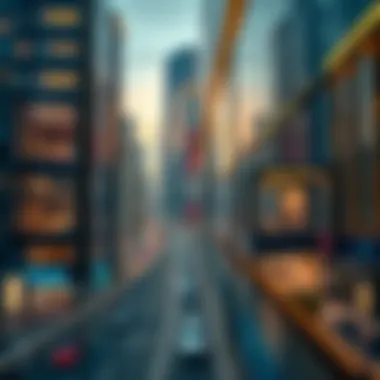

In short, it’s essential to appreciate how Sheikh Zayed Road has not only influenced Dubai's physical structure but also shaped its socio-economic landscape, embodying the spirit of a city that refuses to rest on its laurels.
Key Architectural Features
Sheikh Zayed Road is not simply a pathway through the heart of Dubai; it’s home to some of the most eye-catching architectural features that contribute significantly to the city’s skyline. Analyzing these key characteristics helps to not only appreciate the aesthetics but to also understand the underlying principles that dictate the design and functionality of buildings along this vital road. As urban development continues to evolve in Dubai, these architectural features play a crucial role in influencing both the social fabric and economic growth of the area.
Skyscrapers and Their Design
The skyscrapers peppering Sheikh Zayed Road are exemplary of modern architectural innovation. Each one stands tall, not just as a structure, but as a statement of ambition and progress. Take the Burj Khalifa, for instance—it’s not just the tallest building in the world; it's a feat of engineering and design that elegantly merges form with function. Architects and engineers have meticulously crafted these towers to withstand Dubai's harsh climatic conditions while maximizing stunning views for their occupants.
These buildings often feature unique silhouettes that break away from traditional box-like designs. Curved lines and asymmetrical shapes dominate the skyline, creating a dynamic rhythm. Additionally, the use of glass and steel in their façades enhances light reflection and provides a modern feel, making them work harmoniously within the urban context. Skyscrapers are not only about height; they also incorporate amenities that increase livability—sky gardens, observation decks, and mixed-use spaces are common, fostering a vibrant community.
Innovative Building Materials
Innovation is at the core of the architectural journey along Sheikh Zayed Road. The choice of building materials significantly impacts both aesthetics and functionality. Lightweight, high-strength materials such as carbon fiber reinforced polymer are increasingly utilized, allowing for soaring structures without the burden of excessive weight. Traditional concrete is being supplemented with smart materials that react to environmental changes, such as thermochromic glass, which adjusts transparency depending on sunlight intensity.
Moreover, locally-sourced materials are receiving keen attention. This practice not only reduces transportation costs but also promotes sustainability by minimizing the carbon footprint. An array of brightly colored tiles and reflective surfaces often adorn the exteriors, adding an element of vibrancy to the urban landscape.
"The use of innovative materials is redefining architectural possibilities and enhancing the already unique identity of Sheikh Zayed Road."
Sustainability in Architecture
As the world grapples with climate change, the need for sustainable architecture on Sheikh Zayed Road has gained traction. Buildings are increasingly designed with eco-friendly principles in mind, focusing on energy efficiency and resource conservation. Many prominent structures feature green roofs, which reduce heat absorption and promote biodiversity. Solar panels integrated into the designs allow buildings to generate their own electricity, a crucial step in reducing reliance on non-renewable energy sources.
Incorporating ventilation systems that optimize air circulation while reducing energy consumption is becoming standard. Natural light is leveraged through large windows, expelling the need for artificial lighting during daylight hours.
Furthermore, urban planners are ensuring that future designs not only emphasize aesthetics but also integrate features that nurture the community’s ecological health.
Prominent Buildings Along Sheikh Zayed Road
Sheikh Zayed Road is not just a major thoroughfare; it’s a showcase of architectural brilliance and urban growth. The buildings that line this legendary road are emblematic of Dubai’s ambitions and aspirations. Each structure tells a story, revealing layers of history, design philosophies, and cultural expression. Understanding these prominent buildings provides insight into not just the aesthetics but also the economic and social fabric of the city.
These remarkable structures have transformed the Dubai skyline and play a crucial role in both the local and international identity of the city. Here are four landmark buildings that highlight this aspect:
Burj Khalifa: A Pinnacle of Modern Architecture
Standing tall at a staggering 828 meters, the Burj Khalifa is not only the tallest building in the world but a symbol of Dubai's rapid growth and innovative spirit. Designed by Adrian Smith from Skidmore, Owings & Merrill, this architectural marvel combines traditional Islamic architecture with cutting-edge technology. The building's design incorporates minute details, from its triple-lobed footprint that reflects the Hymenocallis flower to its impressive glass façade that reflects the evolving desert sky.
The Burj Khalifa serves multiple functions, including residential, corporate, and hospitality spaces. Its observation decks offer breathtaking panoramic views, attracting millions of tourists each year.
"Burj Khalifa is not merely a pinnacle of heights, but a statement of a city’s journey towards a futuristic skyline."
This skyscraper embodies the essence of Dubai by pushing the boundaries of what is possible, inspiring architects and builders around the globe.
Emirates Towers: Defining the Skyline
The Emirates Towers, which consist of two sleek structures, contributes significantly to Dubai's skyline. They house a mix of luxury offices and a five-star hotel, effectively balancing commercial and hospitality needs. Designed by the architectural firm of Hazel Wong, the towers are 354 meters and 305 meters tall, respectively. Their modernist design integrates glass and steel, presenting a contemporary and elegant silhouette against the sky.
One of the towers is known for the Burj Al Arab view, making them a great spot for local and international businesses. The Emirates Towers are not just functional; they also represent a shift in corporate architecture, focusing on sustainability and smart technologies.
The Address Hotels: Luxury Defined
The Address Hotels, prominently located along Sheikh Zayed Road, are synonymous with luxury and sophistication. Developed by Emaar Hospitality Group, these hotels meld opulence with exceptional service and design. Each property is designed to reflect a modern Arabic aesthetic, featuring large glass windows and spacious interiors that maximize views of the vibrant city life.
These hotels cater to both leisure and business travelers. The Address Downtown, for example, is just minutes away from the Dubai Mall and offers guests unparalleled luxury experiences, accompanied by distinctive dining options and wellness amenities. Their strategic location along Sheikh Zayed Road further enhances their appeal, making them a top choice for visitors.
Dubai World Trade Centre: A Landmark Convention Hub
The Dubai World Trade Centre stands as a pillar of business activity and international conventions in the region. Initially constructed in 1979, it has undergone several renovations to adapt to the changing demands of modern trade and commerce. This center is not just a building; it's a hub for global business, hosting exhibitions, conferences, and trade fairs that attract participants from around the globe.
Designed by the renowned architect Michael Graves, the building's iconic triangular shape is meant to symbolize progress and ambition, and it's recognized as a key landmark in Dubai. The World Trade Centre contributes significantly to the city's economy by bringing together professionals across various sectors, reinforcing Dubai’s status as an international business center.
In summary, these prominent buildings along Sheikh Zayed Road do more than offer aesthetic pleasure. They embody the ambitions of a city and reflect its socio-economic trajectory. Understanding their characteristics and significance can give us a deeper appreciation for the urban landscape of Dubai.
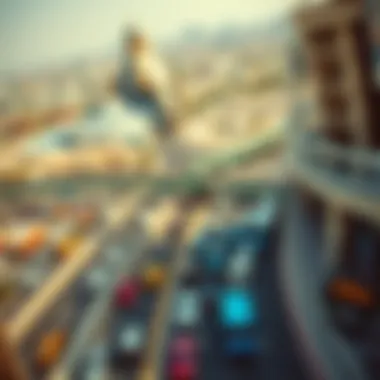
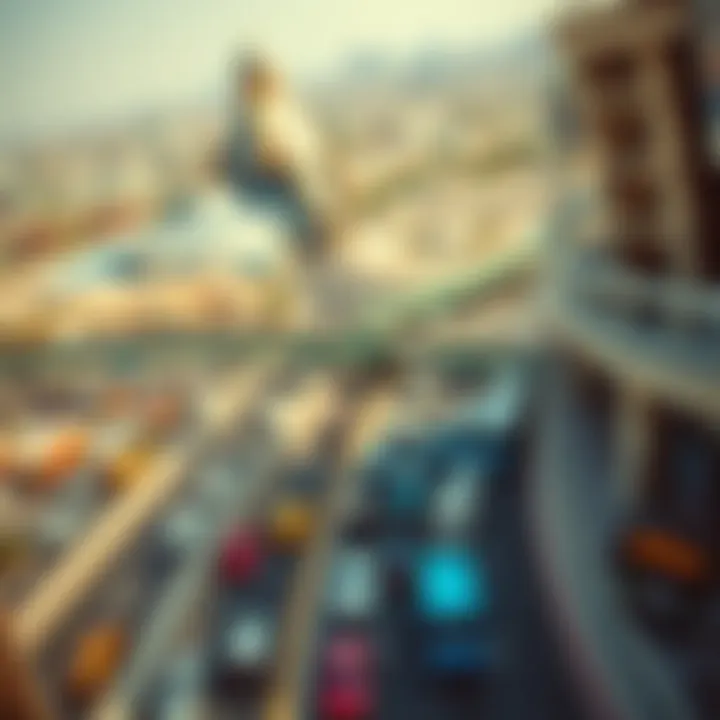
The Economic Impact of Sheikh Zayed Road
Sheikh Zayed Road serves as more than just a thoroughfare connecting various parts of Dubai; it is a driving force behind the emirate's economic dynamism. This road has become synonymous with growth, attracting businesses and tourists alike, while simultaneously shaping Dubai's economic profile. The architecture of the buildings lining this road reflects both aesthetic appeal and practical functionality, exemplifying how urban design can influence economic activity. The resulting synergy between structure and commerce not only enriches the local economy but also enhances Dubai's reputation as a global city.
Business Opportunities Created
The commercial potential of Sheikh Zayed Road is hard to overlook. From high-end retail outlets to influential corporate headquarters, the economic landscape is vibrant and continuously evolving. Major companies establish their headquarters here, benefiting from prime visibility and easy accessibility.
- Attractiveness to Investors: The road's reputation fosters an environment ripe for investments. Investors view the area as a strategic hub, leading to an uptick in real estate development which in turn creates jobs and bolsters the local economy.
- Diverse Industry Representation: Finance, technology, and hospitality sectors have laid foundations on this road, carving out a business ecosystem that encourages collaboration and innovation. The presence of significant players draws smaller businesses, creating a mixed commercial environment that can thrive off one another.
- Networking Opportunities: The dense concentration of businesses facilitates networking. Professionals frequenting the numerous cafes and lounges become part of a vibrant community where collaboration becomes second nature.
"Sheikh Zayed Road is not just an address; it’s an economic catalyst that brings lives and livelihoods together."
Tourism and Hospitality Growth
The impact of Sheikh Zayed Road on tourism and hospitality cannot be overstated. Given its position at the heart of Dubai's tourism infrastructure, the road serves as the gateway to numerous attractions and luxury accommodations.
- World-Class Hotels: Hotels lined along the road, such as The Address Boulevard and the JW Marriott Marquis, symbolize luxury and comfort, drawing both leisure and business travelers who contribute significantly to the local economy.
- Cultural Experiences: Tourists flock to the road not just for shopping or business, but for the plethora of cultural experiences available. From art installations to food festivals, the events organized enhance the tourism appeal, encouraging visitors to spend more time and resources in the area.
- Accessibility to Attractions: With attractions like the Burj Khalifa and the Dubai Mall nearby, businesses thrive in a symbiotic relationship with tourism. Tourists often seek nearby accommodations and dining options, benefitting local hospitality enterprises.
The economic benefits of Sheikh Zayed Road extend beyond its immediate geography, influencing diverse aspects of community and commerce, and setting a foundation for future development.
Transportation and Accessibility
Understanding the dynamics of transportation and accessibility is crucial when discussing Sheikh Zayed Road, an essential lifeline that connects various parts of Dubai. The efficiency of transportation systems not only facilitates movement but directly influences the urban fabric, economic activities, and quality of life for residents and visitors.
Public Transport Integration
An impressive feature of Sheikh Zayed Road is how it integrates public transport. The road is flanked by a variety of options, making it easy for people to get around without relying solely on cars. The Dubai Metro, a speedy and modern transit system, has several stations along this major route, including the Burj Khalifa/Dubai Mall station. This makes it convenient for commuters to hop on the train and reach their destination quickly. Furthermore, the metro's design is an architectural gem in itself.
Besides the metro, bus services also play a significant role in maintaining accessibility. Buses crisscross the road and offer connections to various neighborhoods and key areas of the city. With the RTA (Roads and Transport Authority) implementing smart systems, riders can get real-time updates on bus schedules and routes, enhancing the user experience.
Additionally, the water taxi service on Dubai Creek and various ride-sharing options add further layers to public transport accessibility. These options provide flexibility and cater to the needs of both tourists and locals, making it simpler to navigate through the city, thus taking the pressure off traffic.
Traffic Management Strategies
Traffic congestion on Sheikh Zayed Road can be a significant headache, especially during peak hours. To combat this, a slew of traffic management strategies has been employed. First and foremost, the intelligent traffic systems installed at key intersections play a pivotal role. These systems utilize real-time data to optimize traffic flow, adjusting signal timings based on current conditions.
Moreover, the introduction of measures like dedicated bus lanes has proven effective in minimizing delays. By allowing public transport to move unhindered, these lanes enhance the overall efficiency of the road, encouraging more people to use public transport instead of private vehicles.
In tandem with this, there are ongoing campaigns to promote carpooling. This is a clever approach that encourages residents to share rides, thus reducing the number of vehicles on the road.
"By adopting smarter traffic management strategies, Dubai is setting a standard that other fast-growing cities might look towards."
All these strategies make a compelling case for Sheikh Zayed Road being at the forefront of urban planning and transportation. It's not just about getting from point A to B; it's about efficiency and sustainability for a rapidly growing city.
In summary, both public transport integration and active traffic management contribute significantly to the accessibility of Sheikh Zayed Road. They not only enhance mobility but also create a pattern of urban living where accessibility is prioritized, reflecting Dubai's ambitious vision for the future.
Urban Planning Considerations
Urban planning is the backbone of any thriving metropolis, and in Dubai, it takes on an even greater significance along Sheikh Zayed Road. This critical avenue is more than just a route; it represents a living canvas of architectural brilliance and strategic urban governance. The consideration of urban planning in this context includes recognizing the need for synergy between aesthetics, functionality, and sustainability.
Future Developments and Proposals
The future of Sheikh Zayed Road is a tale in the making, with several exciting proposals hitting the table. As the city gears up for the next chapter in its architectural narrative, the focus is on integrated development that meets the ever-growing demands of its residents and visitors. Here are some key prospects:
- Smart City Initiatives: With technology at the forefront, proposals aim to enhance connectivity through smart transportation systems. This will include advanced traffic management to reduce congestion and improve air quality.
- Green Spaces: Plans are underway to introduce parks and green corridors along this bustling road. This not only improves livability but also enriches the urban ecosystem.
- Mixed-Use Developments: Projects that blend residential, commercial, and recreational spaces are being prioritized. This strategy not only fosters community engagement but can address the urban sprawl challenge.
One can only wonder how these future adjustments will transform the dynamics along Sheikh Zayed Road. Greater emphasis on sustainable architecture and urban design will ensure that the road remains not just a thoroughfare, but a vibrant hub of activity.
Community and Lifestyle Implications
An essential factor in planning along Sheikh Zayed Road is the impact on the local community and lifestyle. As the region evolves, it brings both opportunities and challenges:
- Increased Accessibility: Improved public transport and pedestrian-friendly features are likely to facilitate better access, encouraging more people to explore the area. This, in turn, makes the vibrant community more attractive to families and tourists alike.
- Cultural Enrichment: As developments roll out, providing spaces for cultural events and activities can solidify a sense of identity within neighborhoods. By incorporating local art installations, art galleries, and performance spaces, the community culture remains alive and thriving.
- Community Amenities: Envisioned amenities like community centers, retail spaces, and recreational facilities will cater to residents' needs. This fosters a spirit of community, turning individual spaces into shared experiences.
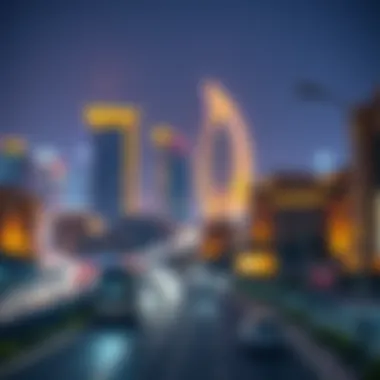
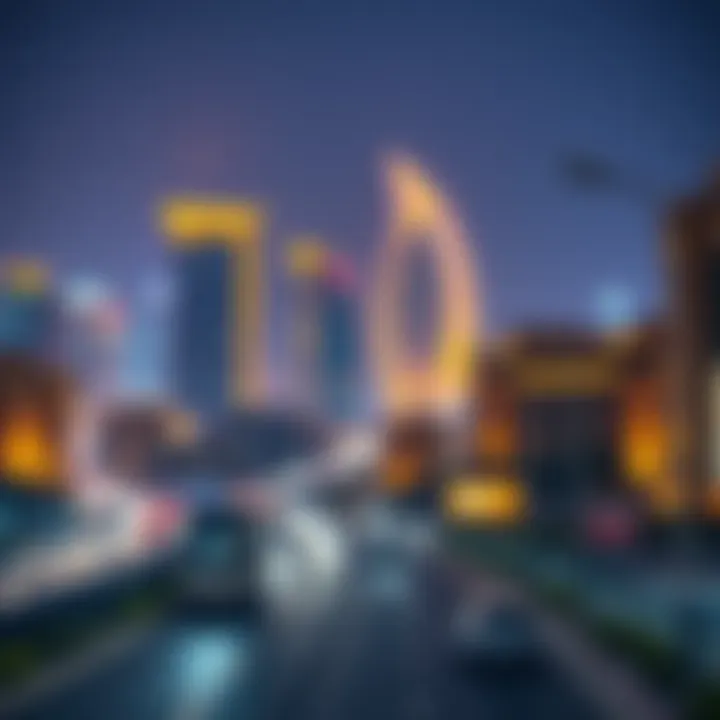
Engaging with the community in urban planning fosters a sense of belonging and creates environments that resonate with people’s needs.
Through these considerations, participation of citizens in the urban planning process is paramount, ensuring that future developments really reflect their aspirations and expectations. The journey of Sheikh Zayed Road through careful urban planning stands as a testament to the evolving landscape of modern Dubai.
Cultural and Aesthetic Elements
The architectural narrative of Sheikh Zayed Road is not complete without recognizing the significance of cultural and aesthetic elements. These features don’t just adorn the skyline; they tell a story of a city that merges modernity with its rich heritage. From the elegant, soaring structures to intricate patterns that echo traditional Emirati designs, every corner of this iconic road reflects a deeper cultural resonance.
Art and Installations Along the Road
Art along Sheikh Zayed Road transforms more than just the concrete borough; it's a canvas that showcases creativity and local talent in a bustling metropolis. Various sculptures and installations dot the landscape, acting as visual anchors that break the monotony of skyscrapers. Notable pieces include the giant "Dubai Frame" that symbolizes a bridge between the past and the present, and the progressive yet nostalgic designs of landmarks such as the Dubai Marina. Certain pieces are made from materials that reflect the region's history, while others seem to float amid the skyline, creating a dynamic interplay between space and form.
Art isn’t just for aesthetic pleasure; it plays an essential role in establishing Dubai’s identity on the global stage.
The inclusion of public art fosters communal engagement, offering avenues for dialogue among residents and visitors alike. Walls adorned with murals highlight stories from Emirati folklore, encouraging audiences to contemplate their significance while navigating the urban environment.
Influence of Local Heritage on Design
Local heritage is the invisible thread woven through the fabric of architectural design on Sheikh Zayed Road. Each structure incorporates elements inspired by traditional Emirati motifs, creating a unique hybrid emblematic of Dubai's rapid evolution. These influences often manifest in the form of mashrabiya—wooden lattice screens that provide both functionality and beauty, enhancing natural ventilation while maintaining privacy.
The interplay between the modern and the historical can also be seen in the ways buildings are oriented around traditional landmarks. For instance, the flow of movement within the structures often mirrors paths used in ancient trade routes, paying homage to Dubai’s roots as a trading hub. Furthermore, the use of color palettes that signify elements of the desert can create a sense of unity, while also reinforcing local identity.
In summary, the cultural and aesthetic elements along Sheikh Zayed Road serve as powerful elements that enrich the visual narrative of Dubai. They accentuate its skyline while also fostering a sense of community among its residents and visitors.
Challenges and Concerns
In any thriving urban landscape, especially one as dynamic as Dubai's, the challenges and concerns surrounding infrastructure grow increasingly pressing. On Sheikh Zayed Road, the very arteries of commerce and tourism pump life into the city, but they also bring a host of environmental and logistical issues that need addressing. These challenges impact not just the skyline but also the daily lives of residents, workers, and visitors alike. Understanding these concerns is essential for making informed decisions about future developments and enhancing the quality of urban life.
Environmental and Urban Sprawl Issues
Sheikh Zayed Road is a major thoroughfare and showcases a remarkable mix of architectural marvels and urban design, yet it isn’t without its environmental drawbacks. Rapid expansion and urban sprawl are two formidable issues faced by the area.
As more buildings rise, the natural landscape gets swallowed up, threatening biodiversity and local ecosystems. A few key factors highlight this concern:
- Loss of Green Spaces: Development often takes precedence over preserving parks or natural habitats, leading to a concrete jungle that lacks places for recreation and relaxation.
- Air Quality Deterioration: Increased vehicular traffic contributes to poor air quality, which can pose health risks for residents.
- Heat Island Effect: Urban sprawl can lead to elevated temperatures in built-up areas, stressing energy resources for cooling purposes.
“Urban expansion often leaves little room for the earth to breathe.”
As concerns regarding sustainability continue to rise, stakeholders need to consider integrating green architecture and landscaping into future designs. Incorporating sustainable practices can help mitigate these environmental impacts and create a healthier urban ecosystem.
Addressing Traffic Congestion
Traffic congestion is almost a rite of passage for anyone who has traveled through Sheikh Zayed Road. Long hours spent in standstill traffic can frustrate commuters and deter potential visitors. To address this pressing issue, several measures have been proposed and implemented:
- Public Transportation Improvements: Enhancing the public transport network, such as the metro and bus services, to reduce reliance on cars is crucial.
- Smart Traffic Management Systems: Utilizing technology to monitor and manage traffic flow can make a significant difference in easing congestion.
- Encouraging Carpooling: Programs aimed at promoting carpooling can help decrease the number of vehicles on the roads.
Each of these strategies focuses on not only reducing the number of cars on the roads but also improving the overall efficiency of transportation systems in Dubai. However, a collaborative effort among residents, city planners, and policymakers is essential for success.
As we pave the way forward, the balance between architectural grandeur and environmental sustainability will define the future of Sheikh Zayed Road. By confronting these challenges head-on, Dubai can maintain its status as a global city while fostering a livable environment for all.
Closure and Future Perspective
The architectural journey of Sheikh Zayed Road is not just a tale of concrete and steel; it represents the dynamic evolution of Dubai—an emblem of its ambitions, culture, and potential for sustainable urban living. In reflecting upon the various aspects explored throughout this article, it becomes apparent that the architectural landscape here is much more than a visual tapestry. It's fundamentally intertwined with economic growth, environmental considerations, and social well-being.
As we assess the future, the sgnificance of this issue cannot be overstated. The buildings along Sheikh Zayed Road do not function in isolation; they are integral components of a greater urban ecosystem. From their innovative designs to the economic opportunities they spawn, insights gained shed light on how future developments can be guided by lessons learned from both successes and challenges encountered to date.
Summary of Key Points
- Sheikh Zayed Road serves as a strategic artery of Dubai, underpinning its commercial vibrancy and architectural innovation.
- The road boasts remarkable buildings, including the iconic Burj Khalifa, each bringing forth distinct design philosophies.
- Economic impacts are felt across various sectors, from business opportunities to a flourishing tourism industry that further enhances the city’s global standing.
- Urban planning in the area necessitates a balance between growth and sustainability, addressing the growing concerns of urban sprawl and environmental health.
Vision for Future Urban Development
As we gaze into the crystal ball of urban planning along Sheikh Zayed Road, certain themes emerge as pivotal for guiding its trajectory:
- Sustainable Design Approaches: Future buildings will likely incorporate more eco-friendly materials and energy-efficient technologies, adhering to greater environmental standards.
- Public Transport Enhancements: A greater emphasis on public transport integration will be key in alleviating traffic congestion and promoting more livable urban spaces.
- Community-Oriented Designs: Urban developers might prioritize community spaces and green areas, enabling residents and visitors to interact more freely while fostering a sense of belonging.
- Cultural Significance: Inclusion of cultural elements in architectural projects could pay homage to local heritage, crafting a more cohesive urban narrative that bridges the past with the future.
With ongoing advancements and community input, it is essential for future developments along Sheikh Zayed Road to reflect a holistic approach that is considerate of both economic aspirations and environmental responsibilities.
The road is not merely a thoroughfare but a phenomenal reflection of Dubai's ambition. It leads us toward a future characterized by innovation and resilience.















